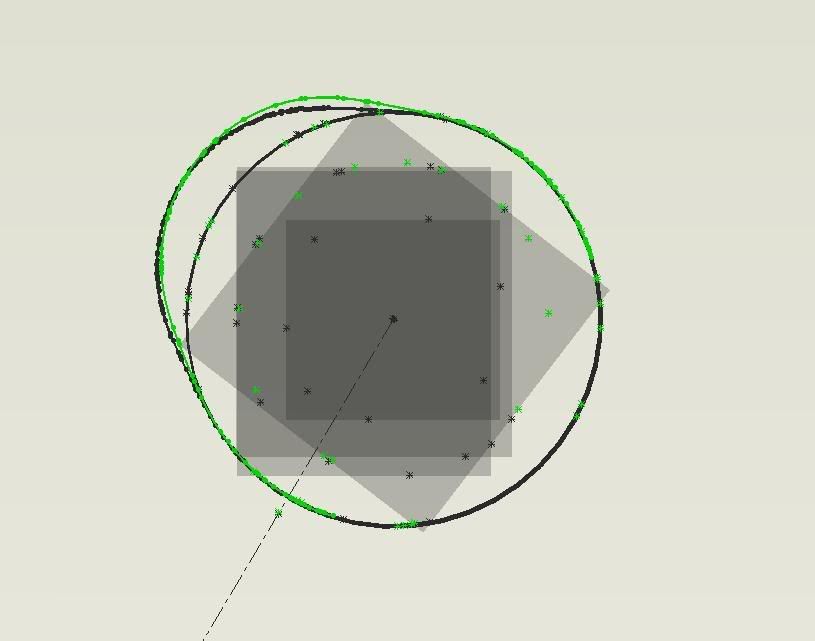TennTechMan
CEG'er
I mentioned in my "Preparing for a 3.0L Port-matched Swap" (http://www.contour.org/ceg-vb/showthread.php?t=40721) that I was going to do some measuring and comparing of the CSVT cams and the 3.0L cams. I did the measuring with an articulated arm coordinate measuring machine. After getting a scan of a pair of lobes from each cam, I over-layed them to really show the true differences between the cams. The cams I'm comparing are 2.5L cams from a 99 CSVT and 3.0L cams from a 2004 Taurus.
The only thing I am not 100% sure of is the timing (rotation) of the cams relative to each other. Each cam gear had a hole in it and a mark near the teeth on the front side of the gear. This hole and mark line up perfectly on each cam gear. Those features are what I used as a rotation reference when I overlayed the cams on the computer. Any comments on cam timing are based on this assumption.
Exhaust cam gear comparison: CSVT cam profile is green, 3.0L cam profile is black. Cam rotation is clock-wise.
SVT duration is longer
SVT opens sooner and closes at about the same time
Base circles are the same
Max lift is the same

Intake cam gear comparison: CSVT cam profile is green, 3.0L cam profile is black. Cam rotation is clock-wise.
SVT primary duration is about the same
SVT secondary duration is longer
SVT primary and secondary open sooner than 3.0L
SVT primary opens at faster rate
Base circles are the same
Max lift is the same

The biggest difference to me is cam timing. The SVT's advanced (relative to the 3.0L) cam timing shows that the SVT cams will build more power higher in the rpm range. The extra duration is also good. Duration is also notably longer on the SVT's exhaust cam and one lobe of the intake cam. The intake cam also opens faster to get more air in sooner. The cam with the largest area between its base circle and the cam profile above the base circle will flow the most air as long as it is timed correctly for where you want to make the power. For someone not tuning, I think the SVT cams especially make sence because the car is fuel-mapped for the higher-revving cams.
To sum it all up, the SVT cams are what will be going into the 3.0L swap I'm currently helping my brother with.
Over the next week, I will try to calculate the specs of each cam for those that prefer to compare cams that way.
The only thing I am not 100% sure of is the timing (rotation) of the cams relative to each other. Each cam gear had a hole in it and a mark near the teeth on the front side of the gear. This hole and mark line up perfectly on each cam gear. Those features are what I used as a rotation reference when I overlayed the cams on the computer. Any comments on cam timing are based on this assumption.
Exhaust cam gear comparison: CSVT cam profile is green, 3.0L cam profile is black. Cam rotation is clock-wise.
SVT duration is longer
SVT opens sooner and closes at about the same time
Base circles are the same
Max lift is the same

Intake cam gear comparison: CSVT cam profile is green, 3.0L cam profile is black. Cam rotation is clock-wise.
SVT primary duration is about the same
SVT secondary duration is longer
SVT primary and secondary open sooner than 3.0L
SVT primary opens at faster rate
Base circles are the same
Max lift is the same

The biggest difference to me is cam timing. The SVT's advanced (relative to the 3.0L) cam timing shows that the SVT cams will build more power higher in the rpm range. The extra duration is also good. Duration is also notably longer on the SVT's exhaust cam and one lobe of the intake cam. The intake cam also opens faster to get more air in sooner. The cam with the largest area between its base circle and the cam profile above the base circle will flow the most air as long as it is timed correctly for where you want to make the power. For someone not tuning, I think the SVT cams especially make sence because the car is fuel-mapped for the higher-revving cams.
To sum it all up, the SVT cams are what will be going into the 3.0L swap I'm currently helping my brother with.
Over the next week, I will try to calculate the specs of each cam for those that prefer to compare cams that way.
Last edited by a moderator:
